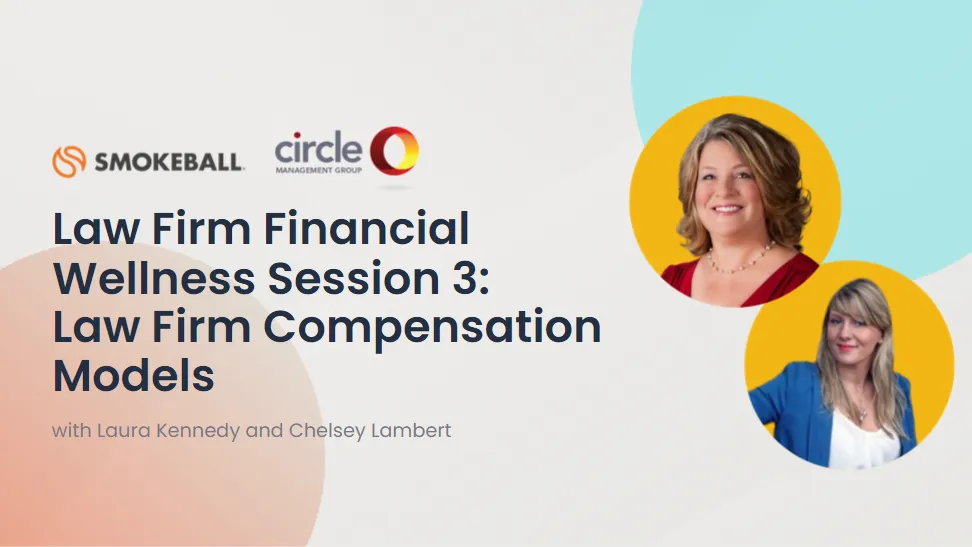Understanding Law Firm Compensation Models: Strategies for Success
Written by
|
August 11, 2023
Written by Smokeball
|
August 11, 2023

Written by Jordan Turk
|
August 11, 2023

In the competitive and dynamic landscape of the legal industry, law firms with 50 or fewer staff have a unique opportunity to devise compensation models that effectively motivate and retain both attorneys and non-attorney staff. The intricacies of law firm compensation models often perplex firm owners, and understanding these models is crucial to fostering a thriving and harmonious work environment. Let's outline the various facets of law firm compensation models, providing insights and strategies for crafting models that align with the firm's goals and values.
Navigating the Complex Terrain of Law Firm Compensation Models
When it comes to law firm compensation models, there is no one-size-fits-all solution. The landscape is marked by diversity, ranging from traditional models rooted in longevity to more contemporary models driven by performance metrics. Each model presents its own advantages and challenges, necessitating careful consideration.
Climbing the Law Firm Ladder: Lockstep Compensation Model
Once prevalent in law firms, the lockstep compensation model celebrates and rewards attorneys based on seniority and tenure within the firm. Under this model, attorneys' loyalty to the firm is compensated according to a predetermined schedule corresponding to the years they've been with the firm. While this approach simplifies compensation calculations, it does not account for performance metrics and can discourage younger attorneys seeking merit-based recognition.
Rewarding Legal Excellence: Merit-Based Compensation Model
The merit-based compensation model shifts the focus from seniority to performance metrics. Attorneys are evaluated based on objective factors such as billable hours, client originations, and successful cases and subjective criteria like leadership and contribution to the firm's growth. This model aligns more closely with the aspirations of newer attorneys who desire compensation in line with their contributions to and achievements in the firm.
Taking Ownership: Eat-What-You-Kill Compensation Model
Often prevalent in solo or small partnerships, the eat-what-you-kill compensation model significantly emphasizes rainmaking, generating business and making client connections. Originating attorneys retain a percentage of fees generated by their clients, and this model tends to create silos within the firm, potentially hampering collaboration among partners. This model requires meticulous structuring to avoid conflicts and incentivize collaboration.
Fusion: Hybrid Compensation Models
Hybrid compensation models blend elements of both merit-based and lockstep models. These models often involve a base salary and additional compensation based on performance metrics. By combining various factors, firms seek to strike a balance between recognizing individual achievements and personal excellence and fostering a cohesive, united team spirit.
Sharing is Caring: Profit-Sharing Compensation Model
Profit-sharing compensation models tie compensation directly to the firm's overall profitability. Equity partners share profits according to predefined formulas that can include factors like seniority, performance, and contributions to the firm. These models align individual success with the firm's financial health, but the complexity of calculations and reporting can be challenging to manage.
Crafting Effective Non-Attorney Compensation Models
Non-attorney staff plays a critical role in the functioning of law firms, and devising compensation models that incentivize their performance is equally crucial and a cornerstone of success. Non-attorney compensation models should ignite motivation in the legal team, enrich job satisfaction, and reflect the firm's goals and values.
A for Achievement: Performance-Based Bonuses
Non-attorney staff can receive performance-based bonuses for the achievement of key performance indicators (KPIs). These KPIs might include metrics like appointment setting, case conversions, or client satisfaction scores. Firms can foster a culture of excellence and accountability by rewarding staff based on tangible contributions.
Celebrating Stars: Recognition Awards
Acknowledging the efforts and celebrating the achievements of non-attorney staff through recognition awards can boost morale and job satisfaction. These awards don't necessarily have to be monetary; they can include additional days off, team-building activities, or contributions to charitable causes--anything that contributes to a feeling of positivity on the team.
Community Involvement and Employee Benefits
Law firms can nurture a strong sense of community by engaging non-attorney staff in charitable and community activities. In addition to monetary compensation, offering benefits such as flexible work arrangements, mental health support, and professional growth opportunities enhances staff satisfaction and retention.
Cultivating a Positive and Sustainable Compensation Culture
The world of law firm compensation models is intricate and multifaceted. Small firms must carefully consider their goals, values, and desired workplace culture when crafting compensation models that resonate with attorneys and non-attorney staff. Striking a balance between rewarding individual achievements and promoting collaborative teamwork is essential for long-term success.
Small law firms can build a strong foundation for growth, client satisfaction, and employee retention by creating compensation models that prioritize performance, collaboration, and well-being. As the legal landscape continues to evolve, the firms that adapt their compensation strategies to meet the needs and aspirations of their team will undoubtedly thrive in a competitive environment.
Learn more about Smokeball document management for law firms:
Book Your Free Demo
Ready to see how Smokeball client intake software helps you Run Your Best Firm? Schedule your free demo!















